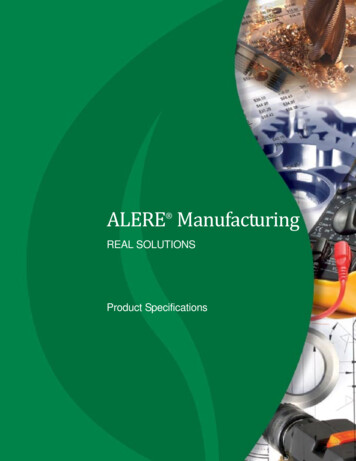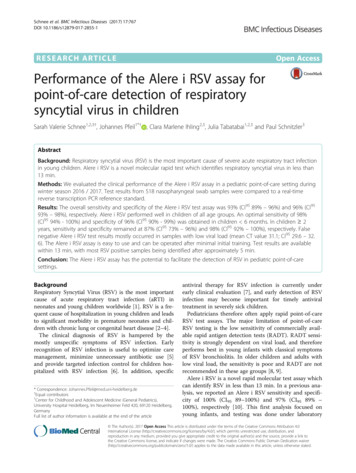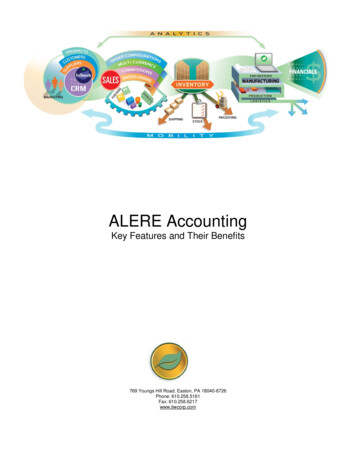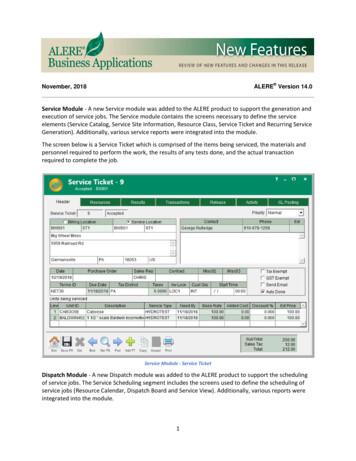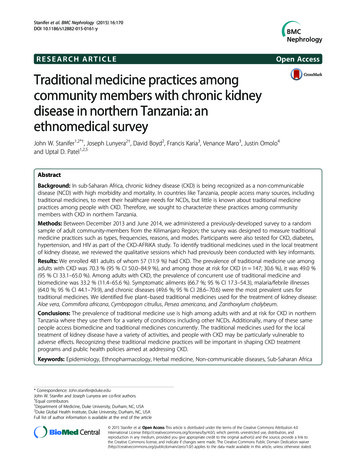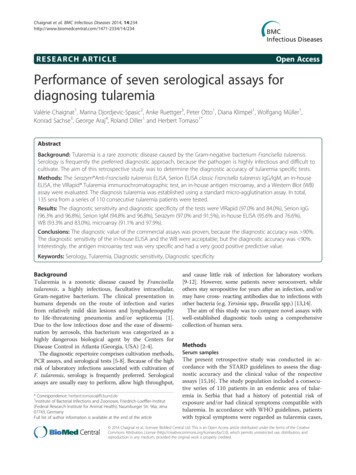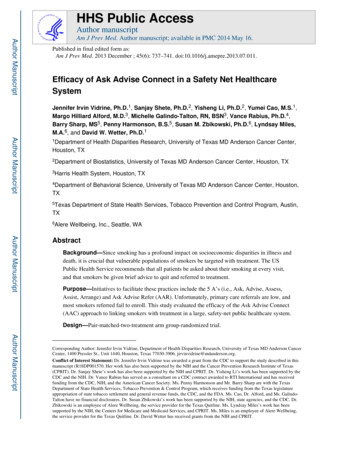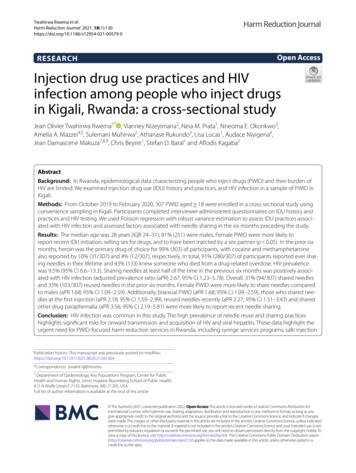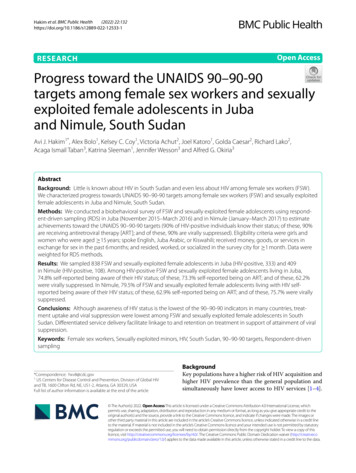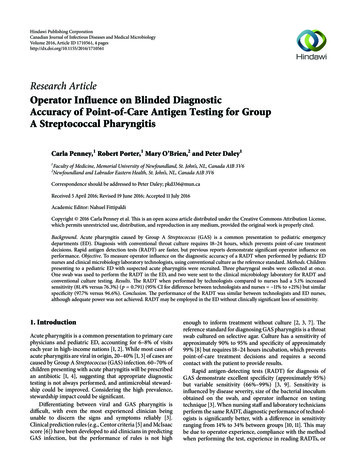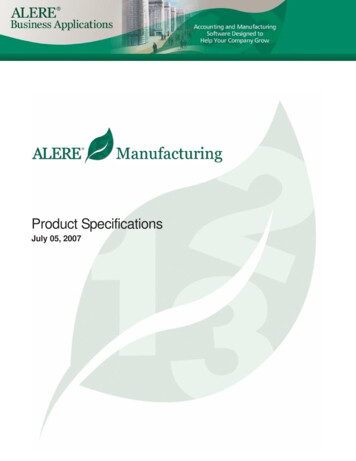
Transcription
Product SpecificationsJuly 05, 2007
ALERE Manufacturing is designed specifically for order driven and make-to-stock manufacturers.Itincludes all the day-to-day functionality that you might expect in a sophisticated manufacturing package. Whatyou might not expect are the carefully designed “extras” that make it work in your environment.Modifiability – The state-of-the-art architecture ofALERE Manufacturing is written in FoxPro and is SQLcompliant, uses object oriented programming (OOP),and is table driven. This means Most modifications are more quickly and easily donethan older source code-only methods. Modifications are portable from one version toanother which saves a company from the expensiveand risky process of rewriting code.MDI (Multiple Document Interface) – MDI permits youto have multiple screens open at the same time. Thisincludes screens of the same type, for instance,having several different sales orders open. To work onany one screen, simply click on it. This helps work flowby Allowing you to work on multiple, different documents at the same time, in a manner similar to theway you work at your desk.Tabularscreens withkey field popup supportModules opensimultaneouslyeliminatingopen-closeroutineEach BOM canhave up to twoimages anddescriptionsFindinformationquickly usingthe Fetchretrieval toolScreen onscreen (MDI)with HypertextrelationshipsNice cleanlayouts withbrowse listsand scrollingwindowsDirectconnection tothe HTMLUser’s ManualLarge, easyto-read iconswith text andtool tipsDynamic Screen Sizing – Screens may be resized ondemand by dragging the screen larger or smaller. Anylists, notes fields or pictures on the screen are automatically sized with the screen. The key uses are Long lists can be more easily viewed and searched. More than one screen can be opened at a time andresized, which allows easy side-by-side datacomparisons to be made. Screen sizes can be preset for each user with asimple modification requiring no code changes. Making it easy to work on a screen, be interrupted,and return to the screen to pick up where you leftoff. Permitting you to open screens with supportinginformation, which makes data entry easier. Eliminating the need to open and close modulesconstantly.Page 2
Fetch Retrieval Tool - This tool is designed to beintuitive, easy to use, and reduce the time it takes tofind information. Fetch is independent of the programmodules so it can left open on the screen where it canbe immediately accessed. Fetch can be used even ifyou are in the middle of doing something else.Using Fetch is simple. For example, a customer givesyou his purchase order number andwants to know the status of a jobyou are doing for him. Enter thePO number and then select the “byCustomer PO” link. His work orderis immediately found and displayed.Global and Local Lingo – Language sets allow you tocustomize menus, screens and even different languages on a local (user-by-user) or on a global (allusers) basis. This feature will literally enable you tohave one user working in English, another userworking in Spanish, and yet a third user working withmenus designed to support only the area he or sheworks in. The benefits are obvious. When a user logsin, they can haveEnterwhat youwant tofind hereEmail & Web Links - Web andemail links that are entered inmemo fields make it easy to send amessage or tie a company’s website to critical manufacturingdocuments. For example, puttingkey contact information on a workorder or adding a supplier’s website to a bill of material.Find awork orderusing acustomerPOAdvanced Browser - Browsershelp find a specific record or pieceof information. ALERE Manufacturing displays a browser each timethe Get button is selected, themouse is double left-clicked in akey field or F2 is pressed on thekeyboard in a key field.Use adescription tofind aninventoryitemHyperlinks – A Hyperlink is arelationship between two screensbased on common information.Hyperlinks have been predefinedthroughout the system in ALEREManufacturing. An example of theiruse would be accessing inventoryinformation on the item for whichyou are taking an order by simplyclicking on Inventory on the menubar and selecting Item Definitionfrom the list. In this case theHyperlink looks at the item numberbeing entered on the sales orderline and automatically gets thematching inventory record. Thebenefits are as follows: Supporting information formany processes is only one or twomouse clicks away. Little or no training is requiredto use this intuitive feature. The way in which work flows issmoother.A browser provides a spreadsheetlike view of a table of information.Each column is a field, function or auser-definable field in the table.Each row corresponds to a recordin the table. A browser allows alarge amount of data to be quicklyviewed. The capabilities of thebrowser are quite extensive. Youcan Resize the browser screen tosee more lines and columns. Rearrange and resize thecolumns. Order the file by any column inascending or descending order. Jump to the first record matchingthe characters entered. Use relational logic to createpowerful filters Display filtered records as a group or within thecontext of the entire table. Save the browser by function and user. Menus designed for only them. Screens and field namesunique to their business. Different languages. Preset defaults. Screen sizes to fit theirhardware.Find aroutequickly andeasilyDiskless Workstation Installation– During the process of installingthe software on a server, a workstation installation program can beoptionally included. When thisprogram is run from a workstation,it configures the workstation to runALERE Manufacturing without theneed to use a CD for the set upprocess. The benefits include Faster workstation setup. Allowing workstations withouta CD drive to be linked to ALERE Manufacturing. Adding additional workstations at a later datewithout the need to find the program CD. Easy network reconfiguration.Page 3
Manager Module SpecificationsYou can choose to post finished goods to inventory attheir actual cost or at their standard cost.This module provides support for housekeeping andthe common information that is shared among themodules. Highlights include:There is support for Average, Standard, LIFO, andFIFO inventory valuation methods.Work orders can be automatically updated with thecalculated schedule completion date.Links to a compatible accounting system’s inventoryfile which allowsYou have control over driving inventory negative whenmaking material issues to jobs. The look up of inventory information. The ability to add new item numbers without leavingALERE Manufacturing. Access to key settings in inventory that are used bymanufacturing.There is limited inventory functionality and customerID support when ALERE Manufacturing is not linked toAuthorization to release work orders to production canbe required.Work orders and material orders can be used at thesame time in ALERE Manufacturing.Key changes may be made for customer, item number,labor grade, location, product class, route number, andwork center.Language Settings permit you to customize menus, screens, and evendifferent languages on a user by userbasis.There are separate general ledgeraccounts for Users canhave multipletypes ofaccess rightsWIP (Work In Process).Variances.Labor.Fixed Overhead.Variable Overhead.A Reconcile Balances function can beused to find and fix differences betweenon order and allocated quantities whenWorkShop is linked to an accountingsystem.Access to basic customer information is provided whenyou are linked to a compatible accounting system.The ability to assign manufacturing and inventorylocations to a group so that MRP (Material Requirements Planning) can be performed on more than onelocation.Reports for inventory and customer information areavailable.Recovering from network related interruptions is fastand easy.An on-line Data Dictionary details the structure of thetables and reports in ALERE Manufacturing.There is system wide packing and reindexing of files oryou can selectively choose areas.Many separate companies can be supported by oneinstallation of ALERE Manufacturing and you cancontrol the order in which the companies are listed onthe menu.A built-in utility checks the integrity of indexes.a compatible inventory system.Period closing functionality is active when you arelinked to an accounting system which requires it.Multiple date formats and time formats are supportedincluding Standard Engineered Minutes to threedecimal places .The number of decimal places can be set on Reports. Bills of Material. Rounding quantity.Extensive security capabilities that can Require passwords based on screens. Require passwords based on users by functions. Allow no access, password access, unlimitedaccess or read only access privileges. Have expiration dates on rights. Enforce minimum password size. Keep a history of password use and not allow reuse.A screen provides a list of all users logged into thesystem.There is direct access to FoxPro from within thepackage.Page 4
Each order can be assigned one of a number ofdifferent priority levels which will be used to set theorder in which it is scheduled.Order Module SpecificationsThe Order Module initiates jobs in the shop, providesthe instructions and material lists for building theitems, tracks the progress of the orders and posts thefinished goods to inventory.A work order can be completely processed using onlyone screen.Several types of orders are supported: AssembleBuildMaintenanceReworkWork OrdersYou can specify that an order is to useonly the work centers specified on theroute or is to use alternate work centersif they will speed up the process.Individual orders can be set to use Forward scheduling techniques tocomplete orders as soon as possible. Backward scheduling techniques tostart the order as late as possibleand still meet the required date.Process anentire workorder on onescreen!Entering an Overlap Quantity on anorder sets the number of pieces to becompleted on a route step before thenext step is started. This significantlycompresses the time it takes to complete a job.Create workorders rightfrom salesorders!Work orders can be created Manually from sales orders.Automatically by the MRP planning process.Manually as required to meet demand.By copying an existing order.Material lists for an order are created automaticallybased on the item being made, the BOMrevision number and the active date ofthe BOM.Routes may be altered on work ordersthat are in process.The list of materials for a job is automatically allocatedin inventory when the job is released for production.Material staging allows material to be issued to a jobwithout releasing it for scheduling.You can specify which route to use whencreating a work order or automaticallyuse the one associated with the itembeing made.The projected finish quantity is automatically calculated when the startingquantity is entered or the startingquantity is automatically calculatedwhen the finished quantity is entered.Edit thematerials on awork orderwhile it is inprocess!Entering a Start Date controls theearliest date an order will be scheduledto be begin when forward scheduling isused.Entering a Needed By date controls thestart date of an order when backwardsscheduling is used.Each order’s expected completion date is automatically updated whenever a new schedule is implemented.A separate tab on each work order screen tracks thematerial that has been issued to the job and thematerial that is remaining to be issued.Page 5
The list of material on an order may have items added,quantities edited, and items deleted in real time withallocation support.Any inventory item may be issued to a work orderregardless if it is on the material list or not.Any item may be returned to inventory from a workorder regardless if it is on the material list or not.Transactions may be posted to a job by Manually entering them on the work order. Batch entering them on a screen designed for rapiddata entry. Using a data collection system to collect the transactions and post them through an external postingprogram.ID’s for lot/serial numbered material can be assignedright on the work order before beingreturned to inventory.Lot/serial numbered material issued toa job can be associated with the lot/serial numbered items being manufactured that used it.Mass releaseand completeorders in onesimple step!A Lot/Serial Tracking report will Show all the lot/serial numberedmaterial that was used to make anitem. Show where lot/serial numberedmaterial was used. Show who purchased the lot/serialnumbered finished goods.Partial quantities on a work order maybe posted to inventory as they arefinished and without completing theorder.An item on an order can be specially designed usingthe configuration capabilities built into the BOM. Thispermits one item number to be built in a number ofdifferent configurations.An inquiry screen allows you to build a list of ordersand their status by specifying an item number, customer and/or a sales order number.You may drill down to the actual order from the list oforders displayed on the inquiry screen.Orders are released to manufacturing by following anFPO (Firm Planned Order) process.Work orders can be optionally printed by operationstep with the materials required.The FPO process permits password control over whohas permission to release orders.During the FPO process the item being manufacturedis placed on order, and the materials required to makeit are allocated in inventory.Pick lists, including ranges of pick lists and pick listsencompassing multiple work orders, may be printed fororders.The use of phantom components are supported.Orders may be mass released, materials mass issued,standard labor mass posted, and the orders masscompleted. You can even mass undo material issues!The FPO process permits lot/serial numbered materialto be specifically allocated to a job.Orders use transactions toYou can control how phantoms and their componentsare displayed on the Pick List report.Completed work orders can be moved to a history file.Orders in the history file can be viewed and used inreports. Indicate which steps have been started and completed. Issue material. Undo material issues. Post labor. Record machine time. Track work in process. Account for scrap. Change the quantity being produced. Post finished goods to inventory.Page 6
Route Module Specificationsthe operation step layout to include information that isunique to your operation steps.The Route Module is responsible for creating andmaintaining the instructions used for manufacturingitems.The user-definable fields can be: Master routes are created and stored in a library filewhere they can be used on work orders.CharactersNumbersDatesLogic fieldsText can be mixed with the user-definable fields.Each route may have up to 999 separateoperation steps.Each step is assigned an operationnumber.Gaps may be left between operationnumbers so that additional steps may beinserted at a later time.Operation steps may be entered in anyorder and are automatically sorted eachtime the route is saved.Matchmaterial to theroute stepwhere it isused!Steps can be reorganized simply bychanging the operation number.Each operation step contains thefollowing:An unlimited number of master routes can be maintained.Operation steps for routes can be defined and storedin an Operation Library .Steps may be loaded from the Operation Library duringthe creation of a master route. The preferred work center to be used. A shrink factor to account for increases or decreases in the WIP quantities. A batch size to set how many of the item are processed per cycle time. The option to overlap steps by specifying whether ornot partial quantities completed on a step will beimmediately started on the next step. Unlimited space to write up the instructions for thestep.Using the Operation Library speeds thecreation of routes and improves productquality by standardizing the operationstep information.The creation and maintenance of routesis accomplished on one screen.Date fields track when the route wascreated and the date it was last updated.Developstandardoperationsteps and savethem in alibrary!Routes can have revision levels.The route and revision level can bespecified on a work order.Drawing numbers can be assigned tomaster routes.Up to twenty (20) user-definable fieldsmay be added to the master route layoutto include information that is unique to your manufacturing processes but not to any particular operationstep.Up to five (5) user-definable fields may be added to A field to record the set up time required to preparefor the job. A field to record the cycle time to complete eachitem or batch of items.Page 7
The labor grades required to perform the set upwork and run the job. The ability to account for split labor when a personruns more than one machine at a time. The advanced scheduling and planning technique,called Synchronous Manufacturing , is support by theAssign Material function. The Assign Material function allows the user to takethe components on a bill of material and associatethem with the route steps on which they will be required.A description.A serial number if applicable.The option to set it as either finite or infinite capacity.The days and times it is available for production.Its estimated efficiency as a percentage.The date it became available for production.An optional overhead rate to be used for costing.A list of up to ten (10) alternate work centers, inorder of preference, that can be used in place ofthis one.An unlimited number of work centers can be createdand maintained.Partial quantities of a component on a bill of materialcan be split among different route steps.Changes to a bill of material that affectthe materials assigned to a route generate a warning to update the route/material assignment.All route steps, and the material assigned to them, may be viewed on onescreen.Assigning material to route steps permitsthe material to be scheduled, just as theroute steps are scheduled, when thefinite scheduler is run.Overheadrates can beassigned toeach workcenter!Up to tenalternate workcenters can bespecified!An item may be associated with apreferred route.Work orders use the item/route association to automatically fill in the routenumber when an order is created for anitem.Costed bills of material use the item/route associationto calculate the labor and overhead costs.Downtime records can be created when a work centerunexpectedly becomes unavailable for production.Downtime recordsRoutes may be created by selectively copying information from an existing route or from a work order.A Time Analysis report allows data collected on workorders to be analyzed to find the min/max/averagetimes for setup and cycle times for each operation stepalong with the duration of those steps.When the work center went off-line.The date and time.The reason.The estimated date and time it will return to production. The actual date and time it returned to production.The time that elapsed and the hours lost are automatically calculated for a downtime record.Machine Module SpecificationsThe Machine Module is used to define the capacity ofyour manufacturing facility, help with maintenance andkeep track of machine downtime.Work centers are a specific production area consistingof one or more people and/or machines that haveidentical capabilities.Work centers are used to establish the capacity of themanufacturing plant for planning and schedulingpurposes.Each work center contains the following: The finite scheduler takes into consideration workcenters that are unavailable and will plan work forwhen they are expected back on-line or for alternatework centers in order to keep production on track.A report permits the analysis of the downtime and liststhe reasons for the work centers not being availableand the associated dates and times.Preventative maintenance instructions can be set upfor individual work centers.A work center can have assigned multiple differentpreventative maintenance records.Preventative maintenance records includePage 8
TheTheTheThenumber of days between service intervals.route to use for service.last work order to perform the service.last service date.Schedule Module SpecificationsA bill of material can be created to support the preventative maintenance work.In the Route module, the bill of material is associatedwith the route that is specified in the preventativemaintenance record.Maintenance type work orders, which include the routeand material list, are used to service work centers.The work orders may be created manually or automatically by the Machine module.The materials requirements planning (MRP) processincludes the maintenance type work orders so thatcomponents required for the service work are availablefor the scheduled maintenance.The Schedule module includesthe maintenance type workorders in its planning so thatspecific times in the productionplan are reserved for scheduledmaintenance.The maintenance type workorders collect labor, materialand overhead costs so that thereal cost of the service work isknown and accounted for.The scheduler is extremely fast and can processhundreds of work orders and thousands of operationsteps per minute.A Trial Schedule permits you to run the scheduler andfine tune it whenever needed.The starting date and time of the day can be set eachtime the scheduler is run and it can handle up to 366days in the future.The estimated completion date for unreleased workorders can be found by optionally including them in theschedule.Acceptable Trial Schedules canbe quickly released for production use.Extremely fastforward/backward finitescheduler!Implemented schedules canautomatically update the workorders with their new estimatedcompletion dates.Option forone hour orone minutescheduleresolution!Jobs that are in process arescheduled from their lastcompleted operation and takeinto consideration the numberof pieces reported completedon each step.A Group Definition functionallows a group of work centersto be created that need toshare some limited commonresource, such as labor ormolds.Each work order can be set toThe Group Definition functionprovides a second constraintand is used by the scheduler toreport when the capacity of thegroup is exceeded.A schedule of the dates and times the factory is closedcan be created. These closed dates and times areobserved by the scheduler.A Change Work Centers function provides a shortcut tomaking mass changes for a range of work centers. Itcan quickly change The on-line date. The efficiency. The dates and hours of operation.Reports are provided for The Schedule Module is responsible for developing aproduction plan for processing work orders throughyour manufacturing facility.Listing work centers.Tracking work centers that are down.Dates the facility is closed.Listing the maintenance activities. Use only the work centers onthe route. Seek an alternate work centerif the one on the route is notavailable within a specifiedperiod of time. Automatically use the work center on the route or analternate based on which will most quickly finish thejob.The single constraint scheduler uses work centers todefine factory capacity.Dates the factory is closed and work centers that areunavailable are automatically taken into considerationeach time the schedule is run.A technique called finite loading is used to schedule.Finite loading means putting no more work into a workcenter than the work center can be expected tohandle.Work centers can be optionally marked as infinitecapacity. This means that the choice can be made toPage 9
selectively treat work centers as if they had no capacity limits. This permits Orders to be concurrently processed at a workcenter instead of sequentially. Work centers that are set up for outside vendors tohandle more than one order at a time. The scheduler can be run at either one hour or onescheduled completion date can be made to matchthe Needed By date.When a schedule is planned, it compares the nextavailable operation start date to the Start/Restartdate and uses the latest one. Therefore, by changing a work order’s Start/Restart date, it is possibleto pause a job, then automatically restart it at a preplanned time without any loss of priority.The scheduler traps problems andprovides a detailed warnings and errorsreport.The Schedule Inquiry option uses theTIW Treevision technology to providean Explorer-like method of viewingscheduling information on four topicsDrill downfor detailedcapacityinformation!Graphicviews of theload on yourshop floor! UsageUsageUsageUsagebybybybyWork CenterPart NumberWork OrderCustomerEach topic allows you to drill down todetailed information on the loads in yourshop, the schedule of individual jobs,the number and status of customerorders, and the quantity and projectedcompletion dates of finished goodsbeing manufactured.minute resolution. This means that when an operationstep is scheduled to end, the next step Starts at the next whole hour when one hour resolution is selected. Starts at the next whole minute when one minuteresolution is selected.Both forward and backward scheduling are supported.Forward scheduling involves a technique whereby theschedule proceeds from a known start date for a workorder and sequentially processes the operations fromfirst to last. Dates generated this way are generally theearliest start dates for operations.Backward scheduling will give the required start dateto meet the required due date.On each work order you can choose whether it is to bescheduled using forward or backward techniques.All of this information is tied to 3Dcharts that are dynamically updated to graphicallydisplay the information you are viewing.Click on the bars on the chart to pop up a window withfurther details.Examine either the Trial or Implemented schedulestarting with any date you set.The Order report shows how each work order isscheduled through the shop on a step-by-step basis.A Work Center report shows the daily list of jobs foreach work center and orders them in the priority inwhich they are to be done.A Completion report lists all the work orders, the datesthey are need by and their scheduled completiondates. Orders that miss their needed by dates areclearly flagged.When a work order is marked for backward scheduling,the Start/Restart date is ignored and the Needed Bydate becomes the date from which the schedule iscalculated.Work orders can be assigned different level of scheduling priorities.Work orders can be made inactive and taken out of theschedule temporarily.The scheduler uses the Start/Restart date on the workorder header as the beginning point for scheduling.This accomplishes two purposes: Without loss of priority, a work order ’s productionrelease date can be set in the future so that itsPage 10
BOM Module SpecificationsKit type bills support kitting at the sales order level byautomatically allocating the components in inventorywhen an order is taken for an item that is a kit.The BOM Module is responsible for bills of materialand for the material requirements planning process.Phantom type bills will pass the demand through to thecomponents without creating a demand for the phantom item. You can also select to havestocking or non-stocking phantomitems in inventory.Bills of material can have revisionlevels with active and inactive dates.Graphicallyview and drilldown onindented billsof material!Individual components can have activeand inactive dates to facilitate thereplacement of components that do notaffect the form/fit/function of a bill andthus do not warrant a new revisionlevel.Createcomplete multilevel BOM’son onescreen!A bill can be set up to behave as anormal component type of bill or as abill which can be configured before it isused.BOM’s can be locked so that changescan not be made without propersecurity rights.There is no practical limit to the number ofHow a bill will allocate its components when it is usedon a work order can be set based on: Parent bills of material. Components (children) on each BOM. Indented BOM levels. The starting quantity of the item being made. The finish quantity of the item, which may be less ormore than the starting quantity.Treevision is used to graphically display bills in anExplorer-like format. With Treevision you canA bill can be set as Peg Exclusive, which forces any onhand inventory for the item being made by the bill tobe ignored when MRP is run. Construct complete indented bills onone screen.Drill down through the indented billstructures directly to the lowest levelcomponents.Do an on-line “where used” and findthe parent bills or even the top levelitem of lower level assemblies andcomponents.Edit or delete items on the bill just byright clicking on them.Each BOMcan have upto two imagesanddescriptions!The children on Component type billscan have negative quantities whichallows dekitting.Modular type bills contain a list ofchoices instead of children, whichcompresses the number of bills requiredto make a configured product.Variable type bills allow numeric information to beentered, such as how many inches, pounds, or unitsare needed to make a product.Components on a bill can be arranged in part numberorder or by the Find Number sequence that you enter.Each component on a bill has an unlimited scratch padarea for entering notes.Page 11
Scratch pad notes are printed on the indented billreport and can be used for things such as specifyingcircuit board locations for the component.Top level bills, which use modular and variable bills aspart of their structure, can take the place of many bills.This approach improves bill accuracy, thus reducinginventory and reduces the overhead associated withcreating and maintaining bills.Bills can have any number of predefined configurations associated
ALERE Manufacturing without the need to use a CD for the set up process. The benefits include Faster workstation setup. Allowing workstations without a CD drive to be linked to ALERE Manufacturing. Adding additional workstations at a later date without the need to find the program CD. Easy network reconfiguration. Enter what you .
